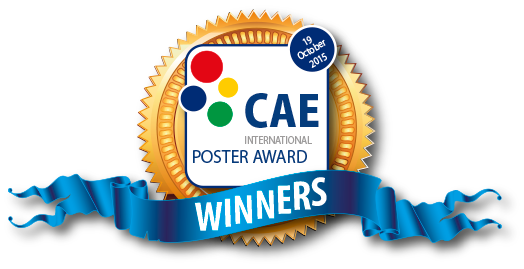
Poster Award 2015 | THE FIVE COMPETITION WINNERS
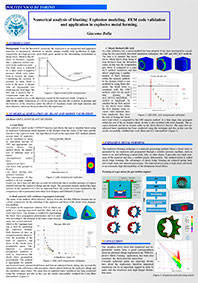
Numerical analysis of blasting: Explosion modeling, FEM code validation and application in explosive metal forming
Giacomo Bolla
Politecnico di Torino - Italy
The development of advanced computational technologies in recent years has seen studies of the effects of explosions on large structures becoming feasible and, as a consequence, the number of destructive tests and their high cost can be reduced significantly. The poster presents a study of air-burst explosion wave propagation using computational modelling based on LS-DYNA. Incident pressure waves are investigated with three differt methods: Load Blast (LBE), Multi-Material Arbitrary Lagrangian-Eulerian (MM-ALE) and LBE-MM_ALE. The results are validated by experimental data methods and the numerical modeling is been used in aerospace application for simulate a explosive metal forming.
Other
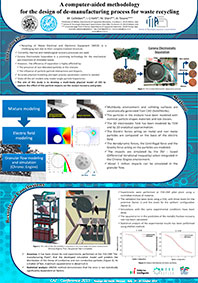
A computer-aided methodology for the design of de-manufacturing process for waste recycling
Marcello Colledani,
Ida Critelli
Politecnico di Milano - Italy
Marco Diani
ITIA-CNR - Milano
Alessandro Tasora
University of Parma - Italy
Corona Electrostatic Separation is a process that separates conductive from non-conductive particles in recycling streams. Its range of application, specifically dedicated to the treatment of small particles, makes it suitable for the mechanical separation of complex multi-material matrices in recycling of electric and electronic equipment. This poster proposes a multi-body, multi-particle simulation model for the prediction of trajectories of metal and non-metal particles trajectories under the effect of particle-particle interactions and collisions. Experimental results show that the model can be used to predict the separation performance as a function of the process parameters.
Environmental
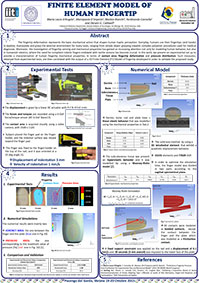
Finite Element Model of Human Fingertip
Maria Laura D'Angelo,
Mariapaola D'Imperio,
Matteo Bianchi,
Ferdinando Cannella,
Darwin G. Caldwell
Istituto Italiano di Tecnologia - Italy
The fingertip deformation represents the basic mechanical action that shapes human haptic perception. Everyday, humans use their fingertips to explore, manipulate and grasp the external environment for many tasks, ranging from simple object grasping towards complex palpation procedures used for medical diagnoses. Moreover, the investigation of fingertip sensing and mechanical properties has gained an increasing attention not only for modeling human behavior, but also in humanoid robotics, where the need for compliant robotic fingers endowed with tactile sensors has become crucial. In this work, we present an experimental set up to provide a characterization of human fingertip mechanical properties, in terms of contact area, fingertip deformation and pressure distribution. Such measures, obtained from experimental tests, are then correlated with the output of a 3D Finite Element (FE) Model of fingertip developed in order to validate the proposed study.
Biomechanics
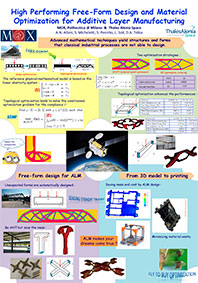
High Performing Free-Form Design and Material Optimization for Additive Layer Manufacturing
Stefano Micheletti,
Simona Perotto
MOX- Politecnico di Milano - Italy
Andrè Nicol Albini,
Daniele Alessandro Tobia
Politecnico di Milano - Italy
Luca Soli
Thales Alenia Space
We present an efficient topology optimization algorithm to solve the minimum compliance problem. Innovative free-form topologies are determined solving a SIMP approximation, a material distribution method defining the optimal shape in terms of a density function.
Other
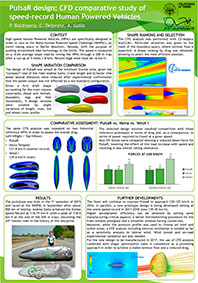
PulsaR design: CFD comparative study of speed-record Human Powered Vehicles
Andrea Gallo,
Cristiana Delprete,
Paolo Baldissera
Politecnico di Torino - Italy
High speed Human Powered Vehicles (HPVs) are specifically designed in order to race at the World Human Powered Speed Challenge (WHPSC), an event taking place in Nevada, with the purpose of pushing streamlined bike technology to the limits. The poster shows the comparative CFD analysis made during the design process of PulsaR. The prototype was built in the 1st semester of 2015 and raced at the WHPSC in September after about 850 km of testing. Andrea Gallo achieved the Italian Speed Record at 116.19 km/h, becoming the 24th fastest rider in the history of this discipline.
Sports
Poster Award 2015 | Special Mentions
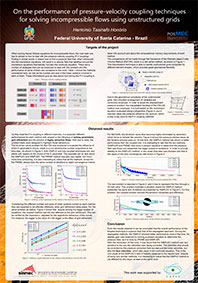
On the performance of pressure-velocity coupling techniques for solving incompressible flows using unstructured grids
Hermínio Tasinafo Honório
Federal University of Santa Catarina - Florianópolis - Brazil
When solving Navier-Stokes equations for incompressible flows, the main task one has to adress is how to deal with the well known pressure-velocity coupling. Putting in simple words, it means how to find a pressure field that, when introduced into the momentum equations, will result in a velocity field that satisfies not just the momentum equations themselves, but also the continuity equation. There are a number of strategies that can be employed to deal with this problem and the performance of some of them are compared in this work. Two dimensional unstructured grids are employed and the Element based Finite Volume Method is used to obtain the discretized equations.
Other
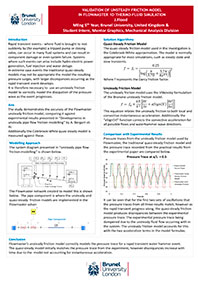
Validation of the unsteady friction model in Flowmaster 1D thermofluid simulation
James Flood
Brunel University - UK
Experimental results from "Developments in unsteady pipe flow friction modelling” by A. Bergant et. Al. are compared with two pipe friction models in Flowaster for a fast transient case. Friction models used in Flowmaster are the quasi-steady friction model, (using the Colebrook-White approximation), and the unsteady friction model, (based on the Vítkovský formulation of the Bronone unsteady friction model). The unsteady friction model used by Flowmater demonstrates very close agreement with the experimental results, while the quasi-steady friction model demonstrates reasonable agreement with descrepancies as the simulation progresses.
Other
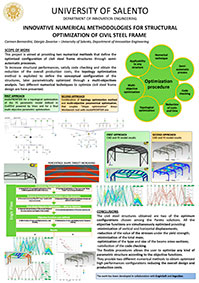
Innovative Numerical Methodologies for Structural Optimization of Civil Steel Frame
Carmen Bernardini
University of Salento - Italy
Two multi-objectives optimization procedures for civil steel frame design are presented. This work is to provides two different alternative procedures to optimize not only the elements’ dimension but also their position within a prototype of a steel frame structure whose goals are user-defined. The structure is fully modeled through beams and joint connections. The integration of CivilFEM and Ansys WB with modeFRONTIER allows the software to work in synergy in a semi-automatic process, to generate the optimized configuration of the civil design and to check it according to the standards.
Civil Engineering
Poster Award 2015 | Nominated Posters

01. In silico replica of an experimental model of coronary stenting: influence of image processing parameters on fluid dynamics
Silvia Bonardelli, Amanda Inzoli, Claudio Chiastra, Gabriele Dubini,
Politecnico di Milano - Italia
Luke Boldock, Cecile Perrault, Andrew Narracott,
University of Sheffield
Coronary atherosclerosis is one of the most common cardiovascular diseases. It is usually treated with angioplasty with stent implantation. The long-term efficacy of this treatment is hampered by in-stent restenosis. The role of endothelial cells in this process will be investigated with an in vitro stented vessel made by the University of Sheffield. In silico replica of the in vitro set up is realized to study experimentally undetectable fluid dynamic quantities (WSS). Starting from µCT acquisitions the sensitivity of the WSS distributions to different image processing parameters is assessed.
Biomechanics
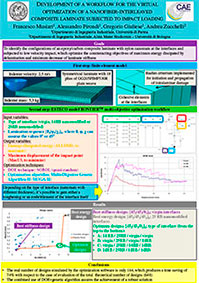
02. Development of a workflow for the virtual optimization of a nanofiber-interleaved composite laminate subjected to impact loading
Francesco Musiari, Alessandro Pirondi, Gregorio Giuliese,
University of Parma - Italy
Andrea Zucchelli,
Alma Mater Studiorum - University of Bologna - Italy
The aim of this work is to identify a way to optimize the impact strength of a composite laminate with interleaved nanomats with respect to the maximization of the energy dissipated by delamination under impact. Impact damage is simulated using the Finite Element Method (FEM). Cohesive elements are placed at the interfaces between groups of plies. Each interface can be assigned 3 different cohesive properties. The optimization workflow realized with the modeFRONTIER software took into account also the possibility of changing the initial ply orientation. A multiobjective optimization was run for the counteracting objectives of max damage-dissipated energy and min decrease of composite stiffness.
Mechanics
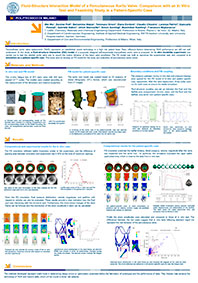
03. Fluid-Structure Interaction Model of a Percutaneous Aortic Valve: Comparison with an In Vitro Test and Feasibility Study in a Patient-Specific Case
Wei Wu, Beniamino Mazza,Tommaso Sironi, Elena Dordoni,Claudio Chiastra, Lorenza Petrini, Giancarlo Pennati, Gabriele Dubini, Francesco Migliavacca
Politecnico di Milano - Italy
Desiree Pott, Simon Sonntag, Maximilian Kuetting, Ulrich Steinseifer
RWTH Aachen University - Germany
To better understand Transcatheter aortic valve replacement (TAVR) performance, a fluid-structure interaction (FSI) model of a Nitinol TAV was proposed. After an in vitro durability test of the valve, the FSI model was built to reproduce the experimental test and compared to a patient-specific case model. Results showed that the leaflet opening area was similar to that of the in vitro test. Furthermore, the FSI simulation quantified the pressure and velocity fields. The computed stent strain amplitudes showed the distribution in the patient-specific case is highly affected by the aortic root anatomy. The patient-specific case also compared to in vivo data on fast valve opening and closing.
Biomechanics
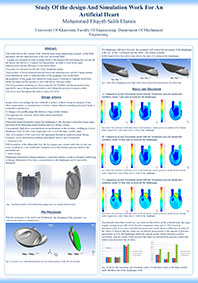
04. Study of the design and simulation for an artificial heart
Mohammed Eltayeb Salih Elamin
University of Khartoum - Sudan
This study discuss the concept of the artificial heart using engineering concepts of the fluid mechanics and the characteristics of the non- newtonian fluid . A pump was designed in order to pump blood to the human body.Three models were simulated in order to study the effect of the pumping work on the fluid.The properties of this pump was studied by using ansys15 software to simulate blood flow inside the pump and the amount of stress that blood will goes under.The 3D geometries modeling done by using SOLID WORKS and the geometries then imported to ansys design modeler which is used during the pre-processing procedure.The solver used throughout the study is Ansys FLUENT.
Biomechanics
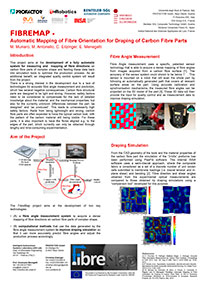
05. FIBREMAP - Automatic Mapping of Fibre Orientation for Draping of Carbon Fibre Parts
Matteo Munaro, Morris Antonello, Emanuele Menegatti
University of Padova - Italy
Christian Eitzinger
Profactor GmbH - Austria
Carbon fibre structural parts are designed to be light and strong. However, safety factors need to be considered to compensate for the lack of detailed knowledge about the material, and the mechanical properties, but also for the unknown differences between the part "as designed” and "as produced”. The FibreMap project aims at the development of a fully automatic system for measuring and mapping of fibre directions on carbon fibre parts of complex shape and feeding these data back into simulation tools to optimize the production process and perform an integrated quality control.
Automotive
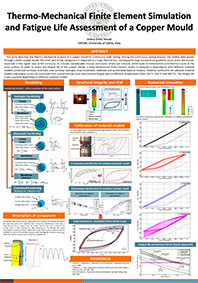
06. Thermo-mechanical finite element simulation and fatigue life assessment of a copper mould
Jelena Srnec Novak
DIEGM, University of Udine - Italy
Poster presents the thermo-mechanical analysis of a copper mould. During the continuous casting process, the molten steel passes through a water cooled mould. The inner part of the mould is subjected to a huge thermal flux. Consequently large temperature gradients occur across the mould, especially in the region near to the meniscus. As a result, considerable stresses and plastic strains are induced in the mould. To assess the fatigue life of the copper mould, 3D finite element model of the mould is analyzed in dependence with the different material models. Material coefficients for used material models and fatigue curves are estimated from isothermal low cycle experimental fatigue data.
Mechanics

07. Numerical analysis of blasting: Explosion modeling, FEM code validation and application in explosive metal forming
Giacomo Bolla
Politecnico di Torino - Italy
The development of advanced computational technologies in recent years has seen studies of the effects of explosions on large structures becoming feasible and, as a consequence, the number of destructive tests and their high cost can be reduced significantly. The poster presents a study of air-burst explosion wave propagation using computational modelling based on LS-DYNA. Incident pressure waves are investigated with three differt methods: Load Blast (LBE), Multi-Material Arbitrary Lagrangian-Eulerian (MM-ALE) and LBE-MM_ALE. The results are validated by experimental data methods and the numerical modeling is been used in aerospace application for simulate a explosive metal forming.
Other

08. A computer-aided methodology for the design of de-manufacturing process for waste recycling
Marcello Colledani, Ida Critelli
Politecnico di Milano - Italy
Marco Diani
ITIA-CNR - Milano
Alessandro Tasora
University of Parma - Italy
Corona Electrostatic Separation is a process that separates conductive from non-conductive particles in recycling streams. Its range of application, specifically dedicated to the treatment of small particles, makes it suitable for the mechanical separation of complex multi-material matrices in recycling of electric and electronic equipment. This poster proposes a multi-body, multi-particle simulation model for the prediction of trajectories of metal and non-metal particles trajectories under the effect of particle-particle interactions and collisions. Experimental results show that the model can be used to predict the separation performance as a function of the process parameters.
Environmental

09. On the performance of pressure-velocity coupling techniques for solving incompressible flows using unstructured grids
Hermínio Tasinafo Honório
Federal University of Santa Catarina - Florianópolis - Brazil
When solving Navier-Stokes equations for incompressible flows, the main task one has to adress is how to deal with the well known pressure-velocity coupling. Putting in simple words, it means how to find a pressure field that, when introduced into the momentum equations, will result in a velocity field that satisfies not just the momentum equations themselves, but also the continuity equation. There are a number of strategies that can be employed to deal with this problem and the performance of some of them are compared in this work. Two dimensional unstructured grids are employed and the Element based Finite Volume Method is used to obtain the discretized equations.
Other
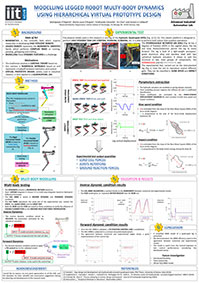
10. Modelling legged robot multi-body dynamics using hierarchical virtual prototype design
Mariapaola D'Imperio, Maria Laura D'Angelo, Ferdinando Cannella, Fei Chen, Darwin G. Caldwell
Istituto Italiano di Tecnologia - Italy
State of Art
• BIOMIMETICS is the scientific field which inspires researches in developing HIGH EFFICIENT ROBOTS.
• LEGGED ROBOTS represents the BIOMIMETIC ORIENTED family which performs COMPLEX TASKS as running, jumping, gallopping and trotting.
• MODELLING these DYNAMIC FEATURES is a challenge.
Motivations
• The traditional solution is CONTROL THEORY based on.
• Our solution is NUMERICAL APPROACH based on and represents a tradeoff between mechanics and control.
• VIRTUAL PROTOTYPE DESIGN, widely used in industrial
robotics, is here applied to a QUADRUPEDAL LEG.
Mechanics

11. Finite Element Model of Human Fingertip
Maria Laura D'Angelo, Mariapaola D'Imperio, Matteo Bianchi, Ferdinando Cannella, Darwin G. Caldwell
Istituto Italiano di Tecnologia - Italy
The fingertip deformation represents the basic mechanical action that shapes human haptic perception. Everyday, humans use their fingertips to explore, manipulate and grasp the external environment for many tasks, ranging from simple object grasping towards complex palpation procedures used for medical diagnoses. Moreover, the investigation of fingertip sensing and mechanical properties has gained an increasing attention not only for modeling human behavior, but also in humanoid robotics, where the need for compliant robotic fingers endowed with tactile sensors has become crucial. In this work, we present an experimental set up to provide a characterization of human fingertip mechanical properties, in terms of contact area, fingertip deformation and pressure distribution. Such measures, obtained from experimental tests, are then correlated with the output of a 3D Finite Element (FE) Model of fingertip developed in order to validate the proposed study.
Biomechanics
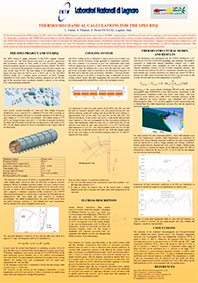
12. Thermo-Mechanical Calculations for the SPES rfq
Luigi Ferrari, Antonio Palmieri, Andrea Pisent
I.N.F.N. / L.N.L. - Italy
In the framework of the SPES project at LNL, a four-vane RFQ (Radio Frequency Quadrupole) operating at 80 MHz is foreseen. The 100kW RF power removal and the frequency tuning with water temperature is accomplished with a system of water cooling pipes. A stationary numerical model in the ANSYS Mechanical environment is conceived in order to calculate the RFQ geometry displacements. Tetrahedral elements for Thermo-Structural calculations coupled with thermal flow elements are used. The main results in terms of global frequency variations vs. both channel inlet water temperatures will be presented.
Mechanics

13. Validation of the unsteady friction model in Flowmaster 1D thermofluid simulation
James Flood
Brunel University - UK
Experimental results from "Developments in unsteady pipe flow friction modelling” by A. Bergant et. Al. are compared with two pipe friction models in Flowaster for a fast transient case. Friction models used in Flowmaster are the quasi-steady friction model, (using the Colebrook-White approximation), and the unsteady friction model, (based on the Vítkovský formulation of the Bronone unsteady friction model). The unsteady friction model used by Flowmater demonstrates very close agreement with the experimental results, while the quasi-steady friction model demonstrates reasonable agreement with descrepancies as the simulation progresses.
Other
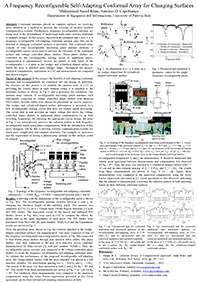
14. A Frequency Reconfigurable Self-Adapting Conformal Array for Changing Surfaces
Muhammad Saeed Khan, Antonio-Daniele Capobianco
University of Padova - Italy
In this project, a new 1 × 4 frequency reconfigurable self-adapting conformal antenna array that can be attached to changing conformal surfaces is presented. This conformal array consists of four reconfigurable microstrip patch antenna elements, a reconfigurable sensor circuit used to measure the curvature of the conformal surface and voltage controlled phase shifters. These phase shifters are controlled by the reconfigurable sensing circuit to implement phase-compensation to autonomously recover the pattern in both bands of 1 × 4 array as the wedge- and cylindrical-shaped surface on which the array is attached. Throughout this project simulations in CST and measurements are compared.
Other
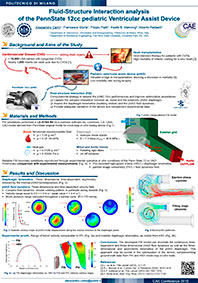
15. Fluid-Structure Interaction analysis of the PennState 12cc pediatric Ventricular Assist Device
Alessandro Caimi, Francesco Sturla, Filippo Piatti, Alberto Redaelli
Politecnico di Milano - Italy
Keefe Manning
The Penn State University - USA
Cardiovascular diseases (CVDs) are the main cause of death worldwide and, due to the limited availability of fresh organs, Ventricular Assist Devices (VADs) are adopted. We developed an innovative characterization of a pediatric VAD (pVAD) adopting a Fluid-Structure interaction (FSI) approach. This method is able to reproduce the behavior of both blood and air chambers and the dynamics of the thin membrane separating the fluids. The developed FSI model can elucidate the continuous, time-dependent and 3D pVAD fluid dynamics as well as the 3D and asymmetric kinematics of the pVAD diaphragm.
Biomechanics
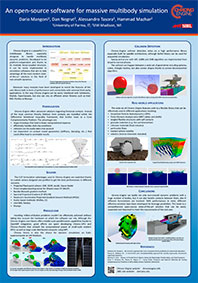
16. An open-source software for massive multibody simulation
Dario Mangoni, Alessandro Tasora
University of Parma - Italy
Dan Negrut, Hammad Mazhar
UW-Madison - Madison (WI)
Chrono::Engine is an open-source multibody C++ middleware library specifically designed to handle million-of-bodies non-smooth dynamic systems involving both rigid and flexible elements. High-performances are reached thanks to a native parallel approach that takes advantage of multi-scale parallelism, from GPUs to clusters. Contacts with Coulomb friction are modelled through a DVI approach, leading to robust while fast simulations. A wide set of bodies, from ANCF finite elements to rigid ones, are available for SPH simulations, soil interaction analysis, particulate flows and much more. Moreover, the loosely coupled structure of Chrono gives to this library plenty of possibilities.
Mechanics
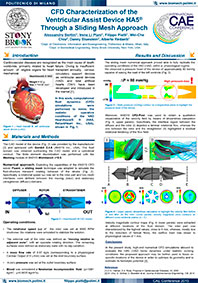
17. CFD Characterization of the Ventricular Assist Device HA5® Through a Sliding Mesh Approach
Alessandro Bertini, Irene Li Piani, Filippo Piatti, Alberto Redaelli
Politecnico di Milano - Italy
Wei-Che Chiu, Danny Bluestein
Stony Brook University - New York
Mechanical circulatory support devices have been developed to bridge heart transplant needs. In this context, CFD simulations were performed to mimic the operative conditions of the ventricular assist devices (VAD) HeartAssist5 ® (HA5, ReliantHeart Inc., USA). We observed a pressure head capable of easing the load of the heart, velocity peaks close to 6 m/s and high pressure drops in the rotor, but physiological values of 1 m/s within the outflow tract. In conclusion, the proposed approach proved able to evaluate the HA5 VAD hemo dynamics and it will be used to optimize its performances.
Biomechanics
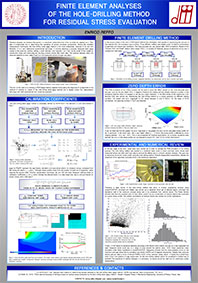
18. Finite Element Analyses of the Hole-Drilling Strain-Gage Method for Residual Stress Evaluation
Enrico Reffo
University of Padova - Italy
Residual stresses are stresses that persist in a structural component even when no loads are applied on it. They play a fundamental role in determining the resistance of several structural components. Among the available measurement techniques, the hole-drilling strain-gage method is the most widespread, because of its cost and flexibility. The aim of this work is to develop a FEM based method capable of simulating the response of components to the removal of material by means of the hole-drilling strain-gage method and to deeply review this measurement technique through both experimental and numerical approach.
Mechanics
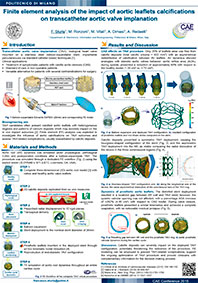
19. Finite element analysis of the impact of aortic leaflets calcifications on transcatheter aortic valve implanation
Francesco Sturla, Mattia Ronzoni, Mattia Vitali, Annalisa Dimasi, Alberto Redaelli
Politecnico di Milano - Italy
Transcatheter aortic valve implantation (TAVI) is often employed to treat severe calcific aortic stenosis (CAS) with heterogeneous degrees and patterns of calcium deposits which may severely impact on the implant outcomes. A complete balloon-expandable TAVI procedure was numerically replicated taking into account all the required procedural steps and including realistic calcific deposits on native aortic leaflets. TAVI postoperative outcomes were investigated throughout an entire cardiac cycle to assess the influence of calcific deposits on both TAVI and aortic root biomechanics.
Biomechanics
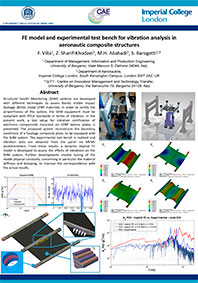
20. FE model and experimental test bench for vibration analysis in aeronautic composite structures
Francesco Villa, Sergio Baragetti
University of Bergamo - Italy
Zahra Sharif-Kodahei, Ferri M H Aliabadi
Imperial College London - United Kingdom
SHM systems are developed with different techniques to assess BVID inside CFRP materials. The SHM equipment must be compliant with RTCA vibration standards. A test setup for vibration certification of electronic components mounted on CFRP lamina plates is presented. The proposed system reconstructs the boundary conditions of a fuselage composite plate, to be equipped with the SHM system. Vibration data are obtained from the panel via MEMS accelerometers, and compared to a dynamic implicit FE model , to assess the effects of vibrations on the SHM system.
Aerospace
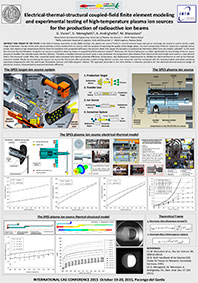
21. Electrical-thermal-structural coupled-field finite element modeling and experimental testing of high-temperature plasma ion sources for the production of radioactive ion beams
Gianluca Vivian, Giovanni Meneghetti,
University of Padova - Italy
Alberto Andrighetto, Mattia Manzolaro
INFN - Italy
In the field of ISOL facilities, the plasma ion source is used to ionize a wide range of elements. This device require a high temperature field to allow the ionization with acceptable efficiency. In this work the electrical-thermal and the thermal-structural behaviour of plasma ion sources is studied in detail by means of coupled field finite element models. After that numerical results were compared with electric potential difference, temperature, and displacement measurements to validate the FEM models. Finally, the plasma ion source thermionic current was measured, and then compared with the analytical values estimated combining calculated temperatures with theoretical relations.
Other
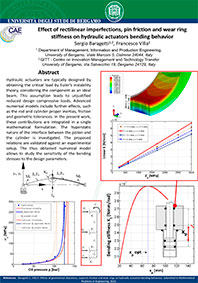
22. Effect of rectilinear imperfections, pin friction and wear ring stiffness on hydraulic actuators bending behavior
Sergio Baragetti, Francesco Villa
University of Bergamo - Italiy
Hydraulic actuators are typically designed by Euler’s critical load, leading to unjustified reduced design compressive loads. Advanced numerical models include further effects, such as the rod and cylinder proper inertias, friction and geometric tolerances. In the present work, these contributions are integrated in a single mathematical formulation, considering also the hyperstatic nature of the interface between the piston and the cylinder. The proposed relations are validated against an experimental setup, allowing studying the sensitivity of the bending stresses to the design parameters.
Mechanics
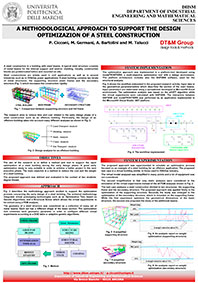
23. A Methodological Approach to Support the Design Optimization of a Steel Construction
Paolo Cicconi, Michele Germani, Andrea Bartolini, Mauro Talucci
Università Politecnica delle Marche - Ancona, Italy
A steel construction is a building with steel beams. The research aims to reduce time and cost related to the early design phase of a steel construction such as an offshore building. Particularly, the design of an offshore building takes into account many different analyses. The aim of the research is to define a method and tool to support the rapid optimization of a steel building during the early design phase.
Oil&Gas

24. A Methodological Approach to Support the Optimization of an ORC Plant During the Early Design Phase
Paolo Cicconi, Michele Germani, Pasquale Toma, Dario Velli
Università Politecnica delle Marche - Ancona, Italy
The Organic Rankine Cycle (ORC) is a technology used to recover heat (300-450 °C) and convert it in electricity. Possible applications are: waste heat recovery, biomass power plants, geothermal plants, solar thermal power, etc. The main design issues concern the definition of operating cycle (temperatures, pressures,) and the study of the optimal power sizing. The aim of the proposed research is to define firstly a method and secondly a software tool to support the designer during the optimization phase. The context is the sizing of an ORC plant with the focus on the thermodynamic cycle.
Oil&Gas
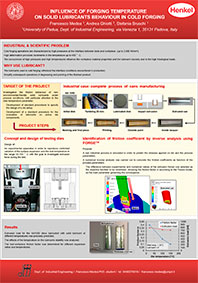
25. Influence of Forging Temperature on Solid Lubricants Behaviour in Cold Forging
Francesco Medea, Andrea Ghiotti, Stefania Bruschi
University of Padua - Italy
One of the most relevant aspects of cold forging operations is represented by the high pressures at the interface between the tools and the workpiece and the high temperature peaks due to material adiabatic heating. The objective of the research work is to investigate the friction behaviour of new environmental-friendly solid lubricants under process conditions, with particular attention to the dies temperature parameter. The case study refers to the impact extrusion of the AA1050 alloy. Values of the friction coefficien are determined through laboratory tests and numerical simulation, reproducing controlled variation of the surface expansion and the tool temperature in the range 20-150°C.
Mechanics
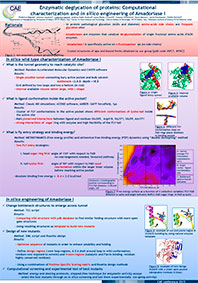
26. Enzymatic deglycation of proteins: Computational characterization and in silico engineering of Amadoriase I
Federica Rigoldi, Alfonso Gautieri, Ludovica Spero, Simone Vesentini
Politecnico di Milano - Italy
Andrea Dalle Vedove, Anna Paola Lucarelli, Emilio Parisini
Istituto Italiano di Tecnologia - Italy
Ravit Netzer, Sarel Fleishman
Weizmann Institute of Science - Israel
Amadoriases are enzymes that can potentially reverse age- and diabetes-related protein glycation. However, wild type forms work only on small substrates (ie, glycated amino acids). We used GPU-accelerated molecular simulations to characterize Amadoriase I enzyme, with particular focus on binding process and active pocket accessibility. We then developed an in silico protocol to design and score Amadoriase mutants with wider tunnel opening. The most promising candidates will be experimentally expressed to test their ability to host larger substrates and eventually provide protein deglycation.
Other
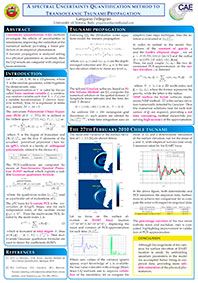
27. A spectral uncertainty quantification method to transoceanic tsunami propagation
Gregorio Pellegrini
University of Verona - Italy
The Polynomial Chaos Expansion technique belongs to Uncertainty Quantification (UQ) methods, which investigate the effects of uncertainties in simulations, providing a finest prediction of the empirical phenomenon described. A tsunami propagation is analyzed setting two physical quantities as uncertain, embedding in the simulation process the lack of knowledge coming from the fluctuations of Earth’s gravity and ellipsoid shape of the Earth. The UQ-results are compared with empirical measurements showing how PCE-simulation provides more reliable data with respect to a single deterministic run.
Other
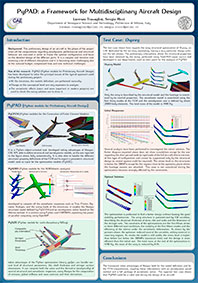
28. PyPad: a framework for multidisciplinary aircraft design
Lorenzo Travaglini, Sergio Ricci
Politecnico di Milano - Italy
The preliminary design of an aircraft is the phase of the project when all the computations regarding aerodynamic performances and structural behavior are executed in order to freeze the optimal configuration and focus on the detailed design of the different parts. It is a complex and iterative task involving a lot of different disciplines and it is becoming more challenging due to the reduced budget, compressed time and new technical challenges. PyPAD (Python module for Preliminary Aircraft Design) has been developed to help the engineers to handle the classical problems of this phase, like the models generation, the sizing loads computation and the sizing of the structures.
Aerospace
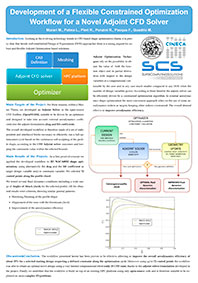
29. Development of a flexible constrained optimization workflow for a novel adjoint CFD solver
Mattia Murari, Leonardo Palma, Maurizio Quadrio
Politecnico Milano - Italy
Roberto Pieri, Francesco Pasqua, Raffaele Ponzini
Cineca - Italy
Looking at the evolving technology trends in CFD-based shape optimization chains it is pretty clear that, beside well-established Design of Experiments (DOE) approaches, there is a strong request for robust and flexible Adjoint Optimization based solutions. This work represents the first step toward the development of a complete open-source routine for shape optimization, based on a new adjoint solver implemented in OpenFOAM.
Aerospace

30. Innovative Numerical Methodologies for Structural Optimization of Civil Steel Frame
Carmen Bernardini
University of Salento - Italy
Two multi-objectives optimization procedures for civil steel frame design are presented. This work is to provides two different alternative procedures to optimize not only the elements’ dimension but also their position within a prototype of a steel frame structure whose goals are user-defined. The structure is fully modeled through beams and joint connections. The integration of CivilFEM and Ansys WB with modeFRONTIER allows the software to work in synergy in a semi-automatic process, to generate the optimized configuration of the civil design and to check it according to the standards.
Civil Engineering
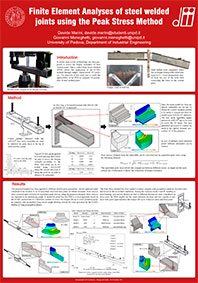
31. Finite Element Analyses of steel welded joints using the Peak Stress Method
Davide Marini, Giovanni Meneghetti
University of Padova - Italy
The Peak Stress Method (PSM) is an engineering, FE-oriented method to assess weld toe as well as weld root fatigue failures using relatively simple, linear elastic 2D or 3D finite element analyses with coarse meshes generated in Ansys®. A single fatigue design curve is used for fatigue strength assessment for as-welded steel joints, whatever the plate thickness, joint shape and loading mode (axial or bending). The PSM is based on the Notch Stress Intensity Factor (NSIFs) approach.
Mechanics

32. Analysis of a reinforced concrete containment vessel by means of multi-layered shell element modelling
Matteo Scolari, Alessandro Stocchi
University of Parma - Italy
Nuclear power plants are used nowadays in 30 countries and many of these reactors need a renewal process. The numerical models calibration via experimental tests is a key point for obtaining reliable solutions for seismic assessment of these structres. In the poster it is reported the analysis of a 1/13 scaled model of a reinforced concrete containment vessel under the effect of cyclic loading tested at the NCREE lab, Taipei. Non linear finite analyses were carried out with Abaqus code by means of multi-layered shell elements. The non linear behaviour of RC structure was evaluated with PARC_CL (secant) and PARC_CL2.0 (with plastic strain) crack models implemented in the user subroutine UMAT.for.
Civil Engineering
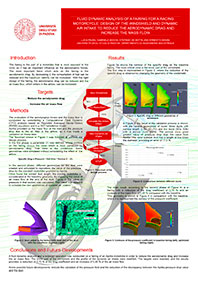
33. Fluid dynamic analysis of a fairing for a racing motorcycle: design of the windshield and dynamic air intake to reduce the aerodynamic drag and increase the mass flow
Luca Pavan, Gabriele Bedon, Stefano De Betta, Ernesto Benini
University of Padova - Italy
A design activity is conducted on an Aprilia motorbike fairing of Superbike category, in order to reduce the aerodynamic drag and increase the air mass flow at the airbox inlet. These operations were performed by modifying the geometry of the windshield and the dynamic air intake. An auxiliary geometry was added in order to simulate the effect of the airbox. The mass flow at the inlet and the pressure drop due to the air filter in the airbox are validated against experimental results provided by Aprilia.
Automotive

34. High Performing Free-Form Design and Material Optimization for Additive Layer Manufacturing
Stefano Micheletti, Simona Perotto
MOX- Politecnico di Milano - Italy
Andrè Nicol Albini, Daniele Alessandro Tobia
Politecnico di Milano - Italy
Luca Soli
Thales Alenia Space
We present an efficient topology optimization algorithm to solve the minimum compliance problem. Innovative free-form topologies are determined solving a SIMP approximation, a material distribution method defining the optimal shape in terms of a density function.
Other
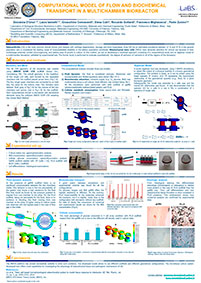
35. Computational model of flow and biochemical transport in a multichamber bioreactor
Giovanna D'Urso, Laura Iannetti, Elena Cutri, Francesco Migliavacca, Paolo Zunino
Politecnico di Milano - Italy
Gioacchino Conoscenti
University of Palermo - Italy
Riccardo Luca Gottardi
Ri.Med - Italy
Osteoarthritis (OA) is the most common clinical chronic joint disease with cartilage and bone degeneration. To better study OA pathogenesis there is the need of having in vitro models able to recapitulate osteochondral system. In this research project, we aim at developing a combined approach consisting of a computational study on ANSYS platform, solving Stokes equations for fluid dynamics and an algebraic model of a multichamber bioreactor designed to mimic the ostochondral layers system. The study provides numerical predictions on the bioreactor fluid dynamics validated subsequently by hisological analysis.
Biomechanics
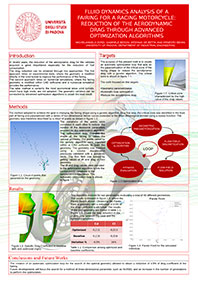
36. Fluid dynamic analysis of a fairing for a racing motorcycle: reduction of the aerodynamic drag through advanced optimization algorithms
Michelangelo Zorzi, Gabriele Bedon, Stefano De Betta, Ernesto Benini
University of Padova - Italy
This work presents an optimization conducted on the fairing of an Aprilia superbike. The simulations are validated through a sensitivity analysis of the mesh performed on the baseline geometry. An area of interest is afterwards identified to perform the optimization activity. This area is parameterized to be described through a series of control points. The location of the control points and consequently the shape of the surface was varied with an optimization algorithm to find the most efficient geometry in terms of drag and lift coefficients.
Automotive
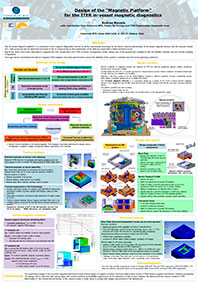
37. Design of the “Magnetic Platform” for the ITER in-vessel magnetic diagnostics
Andrea Rizzolo
Consorzio RFX - Padova - Italy
The “In-Vessel Magnetic platform” is a subsystem of the magnetic diagnostics formed by all the components necessary for the thermo-mechanical interface of the actual magnetic sensors with the Vacuum Vessel (VV), their protection and the electrical connection for the transmission of the detected signal with a minimum level of noise. Significant efforts have been dedicated to integrate the CAD model within the ITER In-Vessel, taking care of the geometrical compliance with the Blanket modules and the remote handling compatibility. Thorough thermo-mechanical and electro-magnetic analyses have been performed to assess the reliability of the system in standard and off-normal operating conditions.
Other
38. Passive methods for drag reduction in boundary layers
Lorenzo Siconolfi, Simone Camarri
University of Pisa - Italy
Jens H.M. Fransson
KTH-Royal Institute of Technology - Sweden
Improving the efficiency of the transport system is one of the main objectives of our time. For many of the common vehicles a significant reduction in drag can be obtained by stabilizing the laminar boundary layer (BL) and avoiding it to transition to turbulence. In literature, it has been shown that a laminar BL can be stabilized by the introduction of miniature vortex generators on the surface. In this study, direct numerical simulations and local stability analysis have been performed in order to compare the numerical results with the experimental ones and to characterize further the stabilization mechanism induced by this type of control.
Aerospace
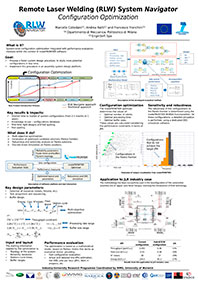
39. Remote Laser Welding (RLW) System Navigator Configuration Optimization
Marcello Colledani, Andrea Ratti
Politecnico di Milano - Italy
Francesco Franchini
EnginSoft Spa - Italy
The early-stage design of automotive assembly lines is a critical, multi-objective task. This design process is usually time and cost ineffective. This research presents an approach to support the design of hybrid assembly lines, using both Resistance Spot Welding and Remote Laser Welding. This approach relies on the use of a Configuration Optimization, based on analytical performance analysis models integrated within modeFRONTIER. With this methodology, the overall cost and required time are drastically reduced. A real door assembly line in the automotive industry shows the effectiveness of the proposed approach in industrial settings, analyzed within the EU FP7 funded project RLW Navigator.
Automotive
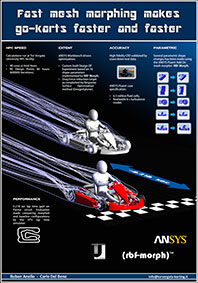
40. Fast mesh morphing makes go-karts faster and faster
Carlo Del Bene, Ruben Anello
University of Rome Tor Vergata - Italy
The present poster illustrates the main steps followed to improve the aerodynamic efficiency of a racing go-kart. The study started from building a consistent Ansys Fluent CFD model validated by coast-down experimental data. Using the mesh morphing software RBF Morph, a number of parametric shape changes has been made in order to explore the best aerodynamic configuration for the vehicle. The most "drag-efficient" combination was chosen thanks to a Response Surface optimization in the Ansys Workbench environment. The improvement was later estimated in terms of time gain thanks to the UTV laptime simulator. All the calculation activities were run at Tor Vergata University's HPC facilities.
Automotive
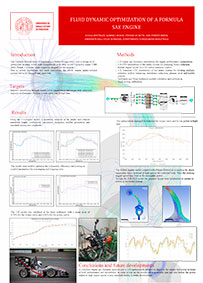
41. Fluid dynamic optimization of a Formula SAE Engine
Nicola Matteazzi, Gabriele Bedon, Stefano De Betta, Ernesto Benini
University of Padova - Italy
The study was conducted to develop a deep research of the non stazionary wave behaviour of a spark ignition engine intake and exhaust system in order to optimize the torque and the power output in the formula SAE competition framework. 1-D gas dynamic, steady and unsteady RANS CFD models were developed to investigate this phenomena. All models went through testbench calibration and validation. Thanks to this study, a new intake and exhaust system was made; the engine performance and the car driveability improvments analysed in track test and race events were confirmed although a further optimization, such as camshaft timing, is ongoing.
Automotive
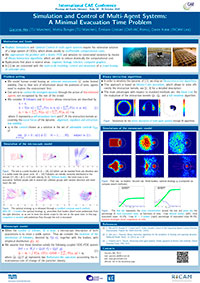
42. Simulation and Control of Multi-Agent Systems: A Minimal Evacuation Time Problem
Giacomo Albi, Mattia Bongini
Technische Universität München - Germany
Emiliano Cristiani
IAC-CNR Roma - Italy
Dante Kalise
RICAM Linz - Austria
We are concerned with the multi-scale modeling, control and simulation of a crowd leaving an unknown area and its evacuation in a minimal time.
Realistic simulations and the optimal control of multi-agent systems require the reiterative solution of a large system of ODEs, which drives usually to unaffordable computational costs when the number of agents is large.
Therefore we rely on the approximation of the dynamic with a kinetic PDE and we simulate its constrained evolution by means of Binary Interaction algorithms, which are able to reduce considerably the computational costs.
Other

43. PulsaR design: CFD comparative study of speed-record Human Powered Vehicles
Andrea Gallo, Cristiana Delprete, Paolo Baldissera
Politecnico di Torino - Italy
High speed Human Powered Vehicles (HPVs) are specifically designed in order to race at the World Human Powered Speed Challenge (WHPSC), an event taking place in Nevada, with the purpose of pushing streamlined bike technology to the limits. The poster shows the comparative CFD analysis made during the design process of PulsaR. The prototype was built in the 1st semester of 2015 and raced at the WHPSC in September after about 850 km of testing. Andrea Gallo achieved the Italian Speed Record at 116.19 km/h, becoming the 24th fastest rider in the history of this discipline.
Sports
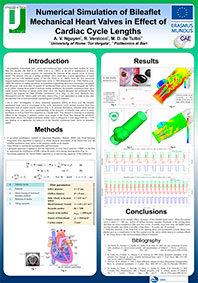
44. Numerical Simulation of Bileaflet Mechanical Heart Valves in Effect of Cardiac Cycle Lengths
Viet Anh Nguyen, Roberto Verzicco
University of Rome "Tor Vergata" - Italy
M. D. de Tullio
Politecnico di Bari - Italy
An in silico investigation of direct numerical simulation of flows over the bileaflet mechanical heart valve is investigated in this work. Simulation results include essential fluid flow parameters such as instant velocity profile, pressure distribution, turbulent shear stresses along the aortic valve provide us understandings of the dynamics of bileaflet heart valves in aortic prostheses as well as blood flow properties in a human heart. This research is focusing on evaluating effects of the changing in pulsatile cardiac cycle length on the blood flow through the prosthetic aortic heart valves. The length of pulsatile cardiac cycle is changed in a wide range (500 ms to 1158 ms).